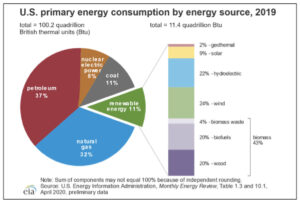Power Makes the World Go Round
Power Makes the World Go Round
There is no substitute for power. Where does this power come from? Oil, gas, coal, water, wind, solar, biomass, and nuclear. As we move ever forward in the development of clean energy our power needs are increasing every year and far outweigh the ability for water, solar, and wind to fully provide the requirements demanded of the global energy grid. Just the effort in reducing pollution by replacing gas-driven vehicles with electric will result in a huge uptick in demand. Where is the power coming from that recharges the batteries in these vehicles? From the power grid fueled by existing energy production.
The solution is nuclear power. However, nuclear power is currently fission-based with its own risks and waste materials, this is not the ultimate solution.
Currently, the power grid in the United States is fueled by: 
It is obvious by looking at this chart the primary non-renewable energy sources are enormous and conceiving their full replacement by wind and solar does not currently seem possible.
Expanding nuclear power is a reasonable solution to producing clean renewable energy. Fission power is a known technology for producing power, requiring highly toxic chemicals which are mined and, in their acquisition, and in the processing required to produce fissile material, expensive. Although fission-fueled nuclear power is a non-carbon producer it also has the critical tradeoff of radioactive waste disposal.
Fusion nuclear power is a clean option using hydrogen derived from water as fuel resulting in no waste or pollution. Globally, many efforts are currently working on bringing fusion power into a viable energy production solution. This eventuality is considered many years down the road.
MIFTI (Magneto Inertial Fusion Technologies, Inc.), a US Nuclear Corp partner, has developed a new type of fusion energy production that will bring fusion power to the marketplace years earlier than other efforts. MIFTI has developed a unique and cutting-edge design for producing fusion power. It will be available for SMR’s (small modular reactors), a current nuclear energy solution proposed using fission-produced nuclear power. The MIFTI design is a clean energy solution without producing waste.
Vehicles for space exploration require fuel that is not solid or liquid. The new US Space Force requires a clean, high-powered, compact, and safe energy source for spacecraft propulsion. It is currently looking at nuclear power, however, the downside of fission-based nuclear power is the risk, expense, and waste disposal. Fusion power, the power that fuels the sun, derived from water is the solution. Fusion-based nuclear power will eventually replace the non-renewable energy resources in use today.
Investors may find additional information regarding US Nuclear Corp. at the SEC website at http://www.sec.gov, or the company’s website at http://www.usnuclearcorp.com
CONTACT:
US Nuclear Corp. (UCLE)
Robert I. Goldstein, President, CEO, and Chairman
Rachel Boulds, Chief Financial Officer
(818) 883 7043
Email: info@usnuclearcorp.com

 Surface water from lakes, rivers, reservoirs, and groundwater is the primary source of drinking water in the United States. Typically drinking water is treated before moving into the municipal delivery system from which at least 80% of the U.S. population receives drinking water. Approximately 14% of the population relies on private groundwater wells, cisterns, and springs.
Surface water from lakes, rivers, reservoirs, and groundwater is the primary source of drinking water in the United States. Typically drinking water is treated before moving into the municipal delivery system from which at least 80% of the U.S. population receives drinking water. Approximately 14% of the population relies on private groundwater wells, cisterns, and springs.